Getting cherry shrimp to breed can be a fun and chances are very good they will reproduce when you keep them happy. We will look at all that is needed to set up an aquarium for breeding Cherry shrimp. If you do it right, you can help a lot of your friends get in the shrimp keeping hobby. If you set up a dedicated shrimp tank for breeding, you might find a way to sponsor your hobby.
We will go through the steps to set up a cherry shrimp aquarium for breeding. And what you can do for your baby shrimp to give them the best start.
Cherry shrimp, also known as Neocaridina shrimp, is an excellent shrimp to start with when getting into shrimp breeding.
All Neocaridina shrimp are the same species, even if they have different colors. Almost all the different colors originated through selective breeding. We will go into this and how this was done in another article.
This setup below is the same for all the neocaridina shrimp, regardless of color.
So much for the intro, let’s begin with how to start a shrimp colony.
To set up an aquarium for cherry shrimp breeding, you have to follow these steps:
- Get an Aquarium
- Add Substrate
- Fill your Aquarium with Water
- Install a filter and possibly a heater
- Add rocks or wood
- Put in some plants and moss
- add Indian almond leaves
- wait for the aquarium to Cycle
- Add shrimp and snails
Let’s go through the steps in detail, and find out the how and why of the steps. After setting up the aquarium, we will discuss some tips on how we can give the shrimp babies the best chance to survive to maturity.
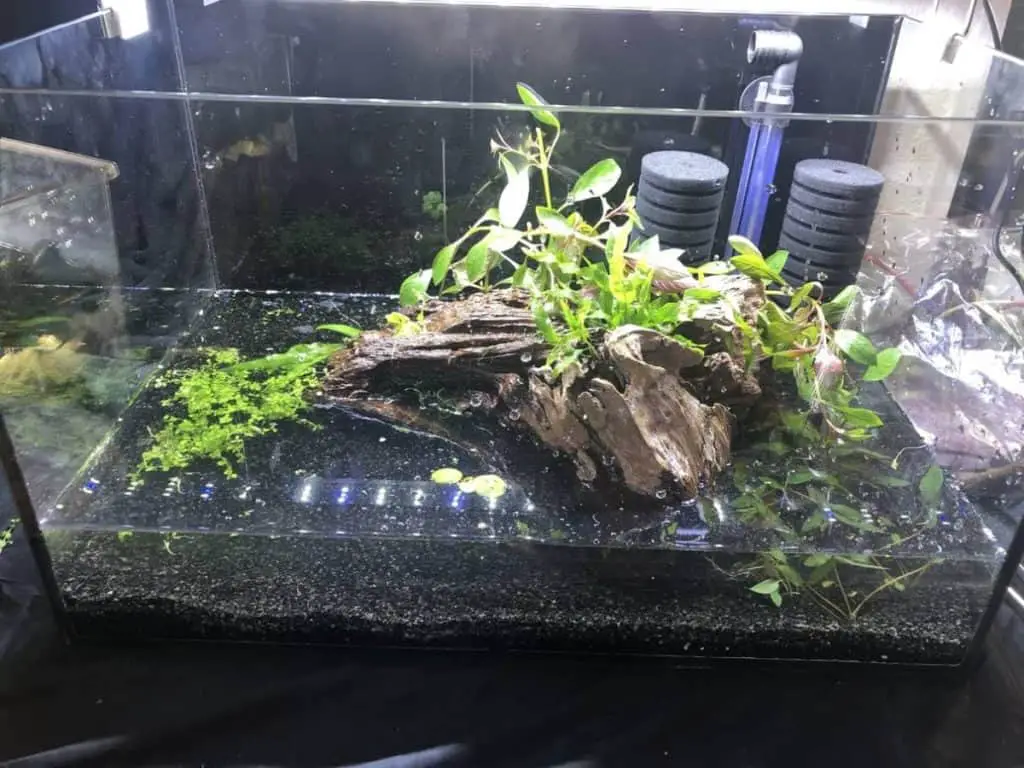
Steps for setting up a good breeding tank for Cherry shrimp
Getting an Aquarium
“New is always better” is what every salesperson said, ever. In the case of a shrimp aquarium, this can be true. I’m all for reusing and recycling but use an older, second-hand fishtank with caution.
When you are getting a second-hand aquarium for shrimp, it is crucial you know the history of the tank. Shrimp are extremely sensitive to metals like copper. You might think: What has copper to do with a second-hand aquarium?
A lot of medications you can buy for treating fish diseases are copper-based. If the previous occupants of the aquarium have been treated in the past, there are chances traces of the treatment remain in the aquarium. Sometimes you can see this is a slight coloration of the silicone. Copper could leach out of the silicone and also applies to substrate or hardscape you might get from another aquarium.
If you are not sure, there are tests you can do to see if there are any trace of copper in your aquarium. Seachem MultiTest Copper Test Kit or API Copper Test Kit are two of the often used copper test kits.
Before you go to the next steps, fill your aquarium with water to see if it’s not leaking. Even when you get a new aquarium, it is good practice. Nothing is worse when setting up a new tank, discovering your aquarium is leaking halfway into your project.
Adding Substrate
Next is the substrate. Choosing the right substrate for Cherry shrimp is more straightforward than choosing one for crystal red shrimp, you don’t need an active substrate for Cherry shrimp.
Neocaridina shrimp can live comfortably on any inert substrate you want, but when keeping cherry shrimp, the best substrate is a black or dark one. A dark substrate, like black gravel, will bring out the best color in your cherry shrimp.
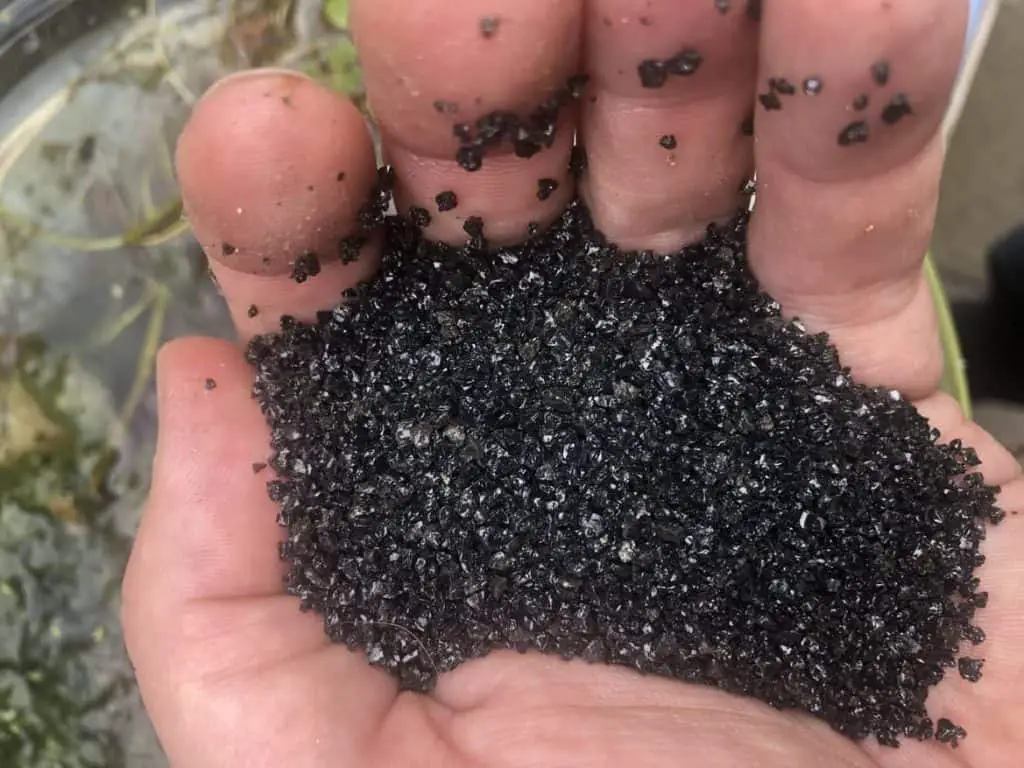
If you are planning to make a planted shrimp tank, use substrates like aqua soil or make a dirted tank. In this article, we are setting up a breeding aquarium, and If you are creating your setup for this purpose, I would only use gravel or pool filter sand as a substrate. Gravel or pool filter sand is the cheaper option compared to aqua soil and the like.
A small layer of dark-colored gravel will already give your shrimp a lot of surface area where your shrimp can graze on biofilm. You should get a layer of the substrate of at least two inches deep. Two inches will be deep enough if you get some plants. A good practice is to rinse the substrate before adding it to the aquarium; the water will be much clearer.
Fill your Aquarium with Water
It is now time to fill your aquarium with water.
I have seen many setups for neocaridina shrimp, where they used tap water or well water. If you have a well-established aquarium, you could also do water changes using tap water in some cases. If this can work for you depends on the water quality you have. Even if your water quality is good and you have tested it, you still have to be careful. Water companies do not always have the same water quality or composition of additives all the time; it can vary throughout the year. Some additives they put in the water to make it healthy for us to drink might not be the best for your shrimp.
A better option, and the one I’m using at the moment, is to treat the water with a water treatment product. It neutralizes the most common harmful substances in the water like chlorine, chloramine, copper, zink, and lead in some cases. Using a water conditioner to improve tap water quality is an easy way to get good water for your shrimp tank. Just add some drops to your bucket of tap water, mix it a bit, and you have a lot better water than plain old tap water.
If you don’t have a water conditioner, you can also tap a bucket of water and leave it for a couple of days. Most chlorine will evaporate eventually.
The best option is to take ‘pure’ water and only add the substances to the water your shrimp needs. The closest you can come to this is to use reverse osmosis water and use a special remineralize to add the needed minerals for your shrimp. To get RO water, you can buy in aquarium stores or the supermarket, or you can get a reverse osmosis unit and make it yourself. A reverse osmosis unit filters things like chlorine and metals out of your water. Next, you will need to remineralize the water with products like Salty Shrimp. This way, you know precisely the quality of water goes into your aquarium.
Install a Filter
What filter to choose for a shrimp breeding project? There are a lot of different filter options out there you can use. Sponge, Mattenfilter, under gravel filter, hang on the back filter, canister filter. The filter we would choose for this setup will be a Sponge filter or a Mattenfilter. We have an article where we go over most of the different filter options, how suitable they are for a shrimp breeding aquarium here.
Adding a Heater or not?
Do cherry shrimp need a heater? Cherry shrimp don’t need a heater to live. When choosing whether or not to add a heater, you have to consider several things. You might want a heater to speed up the breeding process, but maybe the room you are using is already warm enough. We have a more in-depth article here below you might find interesting where we discuss de various reasons why you might want a heater in your breeding tank and why you might not.
Cherry shrimp can live in a wide range of temperatures, ranging from 57F to 86F or 14C to 30C. With higher temperatures, the shrimp will grow and breed faster, but they will also live shorter. The optimal temperature for a breeding setup to produce lots of shrimp fast is about 77F to 81F or 25C to 27C.
Adding Rocks and Wood
Adding rocks or wood to your breeding setup is not just lovely for the aesthetics. There are several reasons to add them to your setup.
- Rocks and wood add a lot of extra surface area where biofilm can form for your shrimp to graze on.
- Wood has the added benefit of, for a time, releasing beneficial tannins to the water.
- Wood and stones will provide cover to shrimp after they have molded.
Cover for Shrimp After Molding
when shrimp grow, their outer shell does not grow with them. When their shell gets too small, they will shed their shell. When they shed their shell or mold, the shrimp are very vulnerable for a while till their new shell hardens.
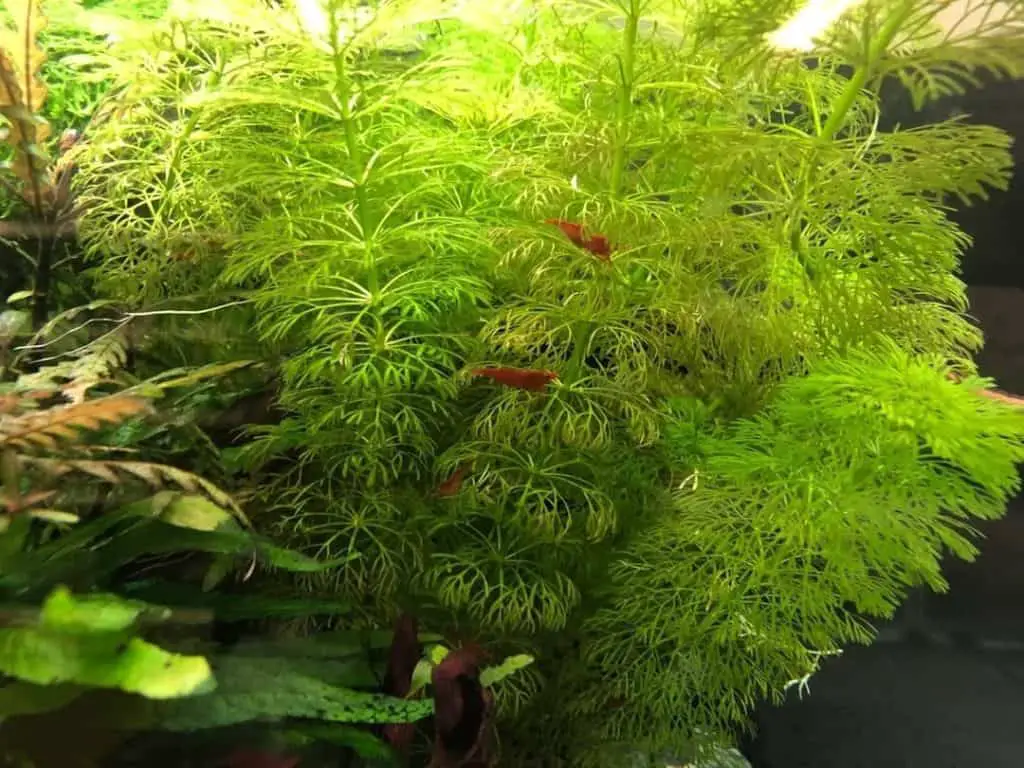
In this vulnerable period, the shrimp likes to hide because, in the wild, there would be a higher chance of being eaten. If you want to make your shrimp feel more comfortable, it is essential to provide them with enough place to hide. In the end, this will result in your shrimp living better, happier, longer, and breeding with more success.
Wood can Release Beneficial Tannins
Both rocks and pieces of wood can provide enough hiding spots for your shrimp to hide after molding. Wood, however, has the added benefit in some cases of leaching beneficial tannins in the water, just like the beneficial tannins of some leaves. Same as rock, they will provide extra surface area for biofilm to form on.
Putting in Plants and Moss
Plants are an essential ingredient for maintaining optimal water quality. By merely growing, they consume a lot of the waste, from leftover food to other decaying mater, that build up in the water that is nutrients to the plants. This way, healthy plants help to prevent the build-up of nitrates.
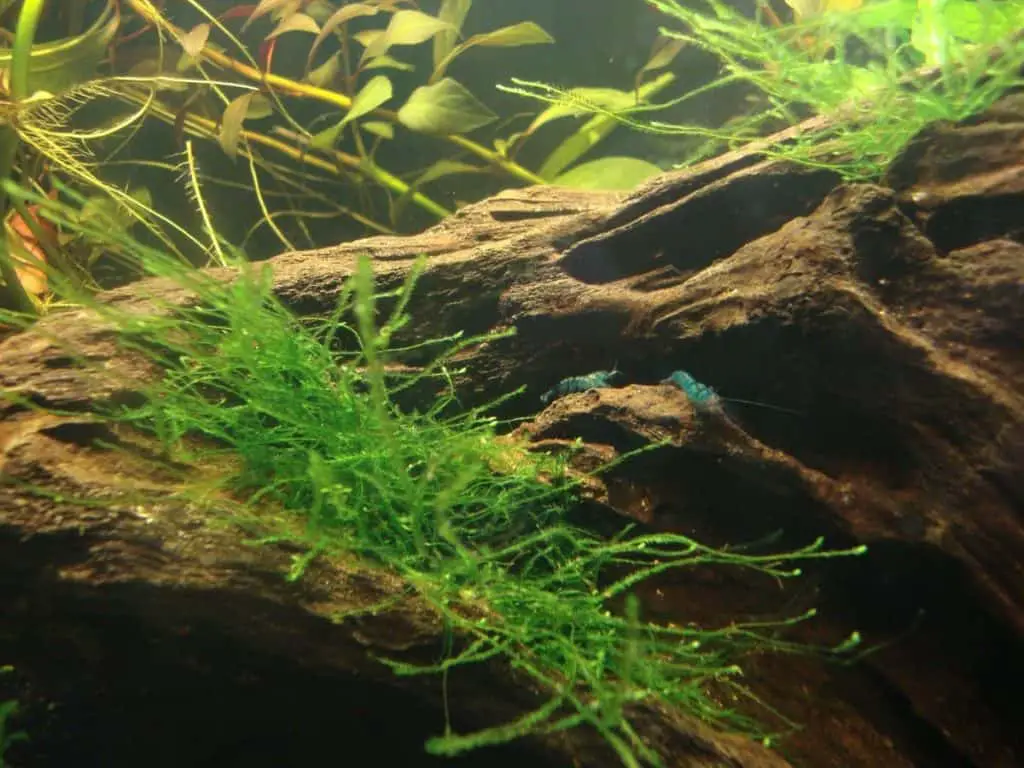
Plants and moss provide surface area for your shrimp to graze on. Plants and moss also offer lots of places where your shrimp can hide and feel safe.
Plants prevent or slow the growth of algae because they compete with the algae for the nutrients in your tank.
Add Indian Almond Leaves
Indian Almond leaves have many benefits for your shrimp. One of the main benefits is they give of antibacterial and antifungal tannins to the water. Not only that, but they add a surface for your shrimp to graze on. Your shrimp can eat the biofilm that forms on the surface of the leave together with the leave itself. Another good thing to add to your shrimp tank that has similar properties are alder cones. We have an article that goes more in-depth Why Indian Almond Leaves are beneficial for your shrimp.
Add shrimp and Snails
Finally, the moment is there to add your cherry shrimp. Shrimp are very sensitive to changes, so you cant plop then into your new breeding setup. A sudden change will shock them, and they could die. Maybe they don’t die of shock immediately it could happen over the period of a week or two.
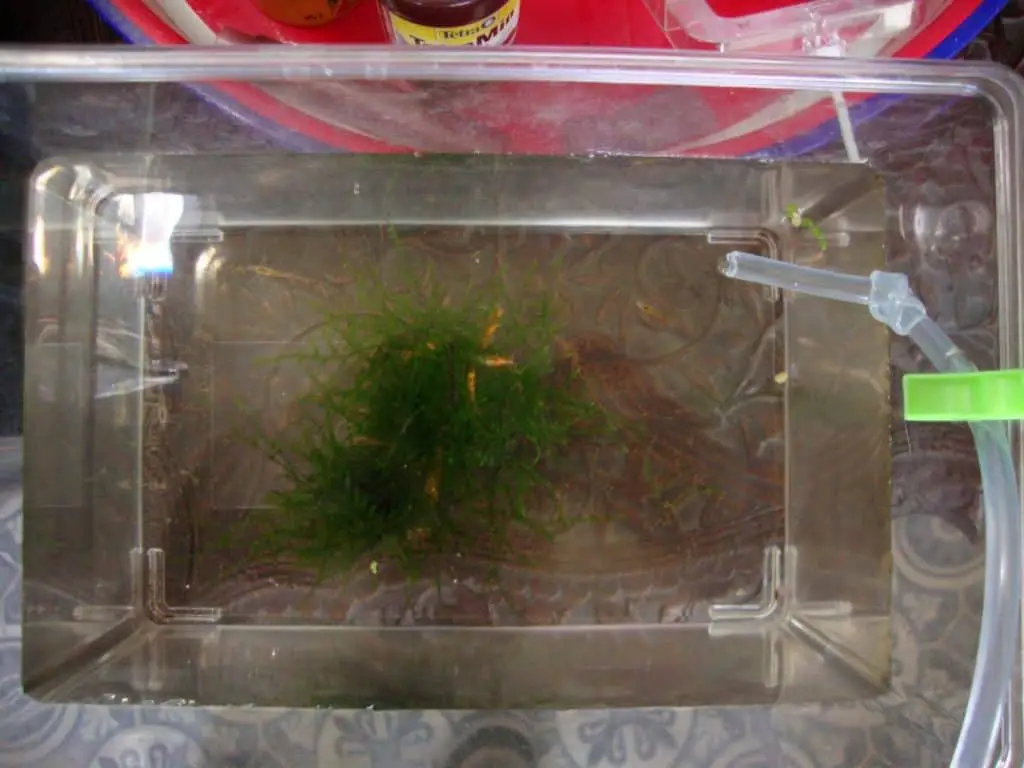
My favorite method of acclimating shrimp is to drip acclimate. Drip acclimating is a simple method of adding aquarium water to the container where your shrimp are in, one drop at a time. To do this, you make a siphon from a piece of spare air hose, but instead of just letting it flow freely, you tie a not in the air hose that constricts the water flow just enough only to let out one drip at a time. About one or two drips a second for at least twenty minutes should do the trick. Your shrimp will slowly get used to the water of your aquarium.
How Many Shrimp do you Need to Start a Breeding Colony?
It is a good idea to get a least ten shrimp when starting a breeding colony. Ten is a good number for tanks up to 20-gallons. This way, chances are there are enough males and females to make it easy to find each other and enough to have the right mix of the two genders.
If you start with a bigger aquarium, consider adding more shrimp, this way more females can get pregnant, and your colony will grow from the start so much faster.
Whether you are starting a new colony, or already starting to have success with one, it is good to get your shrimp form more than one source. Getting your shrimp from multiple sources will add to the biodiversity, and shrimp will potentially be more robust.
How to Distinguish Males from Females
distinguishing male from female is fortunately not very hard when they are adults, but it can be difficult when they are still juveniles. You can tell them apart by their most significant difference, their abdomen. The abdomen of the males are more slender than that of the females.
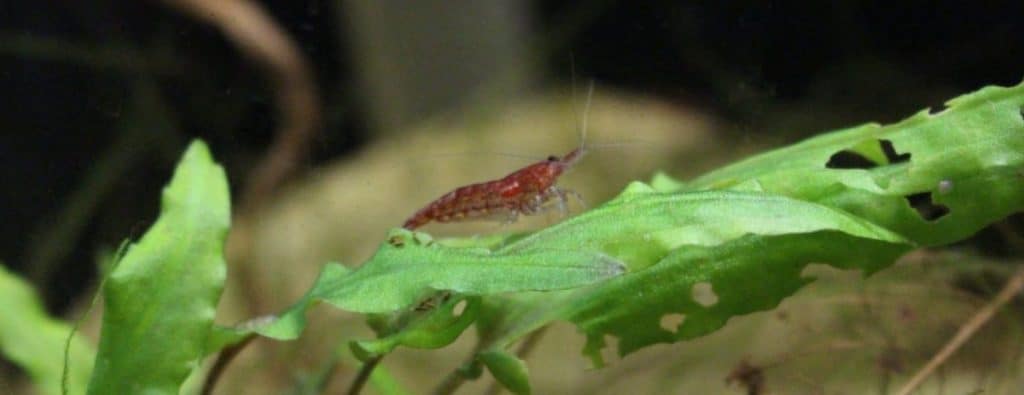
You cannot accurately distinguish male shrimp from female shrimp by color, but sometimes the female shrimp can have darker or brighter colors than males. This fact is essential to keep in mind when selecting your shrimp. If you only choose the darkest or brightest shrimp to continue breeding, you can end up with an aquarium full of females and no males. This, of course, will make breeding impossible.
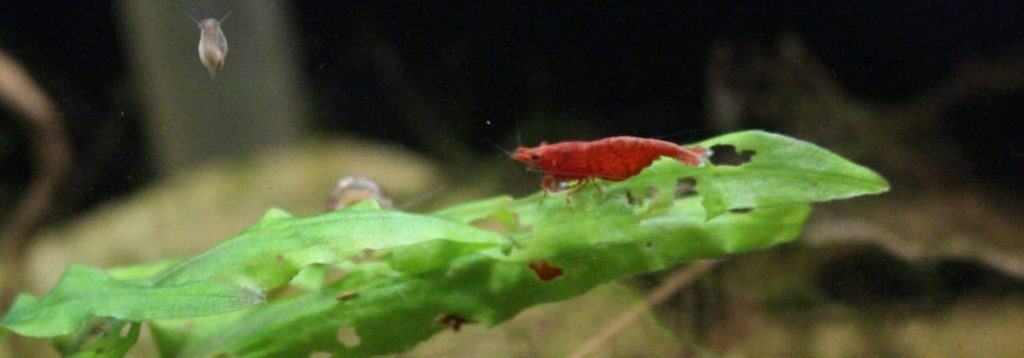
When you are selecting shrimp for your starting colony or culling your shrimp, keep to the shape of the abdomen first en color second.
How Long Does it Take for Cherry Shrimp to Breed?
It will take about three to five months for Cherry shrimp to reach maturity. From that point on they will reproduce. When the female shrimp is about that age, she is what they call ‘saddled.’ These are the eggs growing inside the female shrimp’s body before the male shrimp have fertilized them. The female shrimp will go trough shedding her shell, and then she will lay her eggs and keep them under her appendage. There the eggs get fertilized, and she will carry them around till they hatch into little shrimplets.
Giving your Cherry Shrimp Babies the Best Start
your baby shrimp, or shrimplets, need three essential things to survive and thrive. They need a stable environment, enough places to hide, and food within reach. For enough surface area for them to graze on, and a place to hide, you can use moss and hardscape.
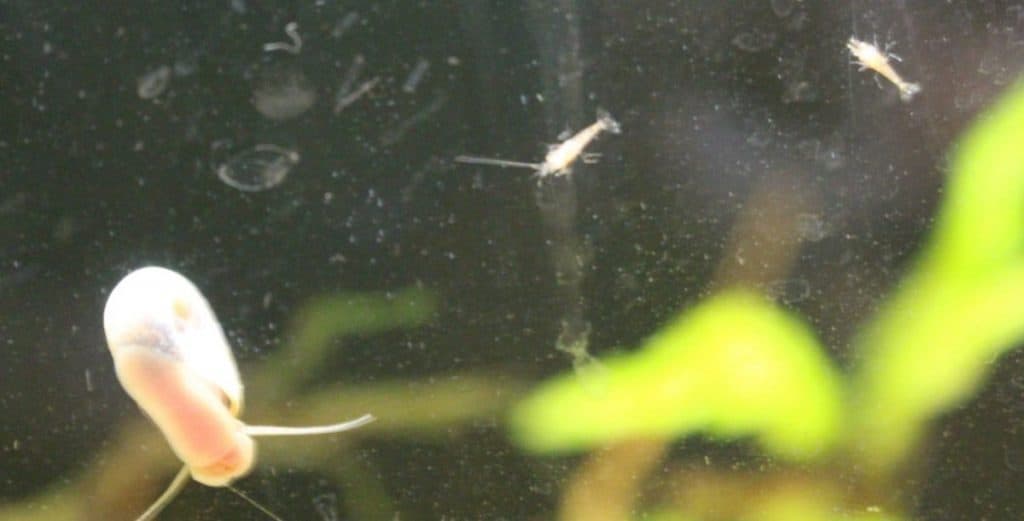
Baby shrimp, when they are tiny, will not go far to find food. Enough algae, bacteria, and biofilm must be near them, so they don’t starve. For baby shrimp, there are food in powder form and things to stimulate the growth of biofilm.
Water Changes
Like we discussed before, shrimp can’t stand significant changes to the water conditions. This fact also applies to water changes. Don’t do massive water changes, or your shrimp might perish. It is better to do water changes of 10% once a week or once every other week than to do a 50% change once a month.
At the moment I do a 10% water change every two weeks, but I’m trying to breed as much as possible. If your goal is breeding as much shrimp as possible you and you feed your shrimp a little more than a weekly 10% water change would be better as the water might get polluted a bit faster.
Conclusion
Cherry shrimp and Neocaridia shrimp, in general, are not difficult to breed. If you take the steps described here, you will see your shrimp not only survive but thrive with lots of little baby shrimp.
Related Questions
Will Cherry shrimp breed in a community tank? Cherry shrimp will breed in a community tank, but there is a big chance the babies get eaten before they mature if there are not enough hiding places for the shrimp babies.
How many babies do cherry shrimp have at a time? On average, Cherry shrimp will have 15 to 20 babies at a time. The number of babies can go up to 30 at a time if the shrimp has more experience carrying eggs.
What is the difference between cherry shrimp and blue dream shrimp? Cherry shrimp, blue dream shrimp, green, yellow, have no difference except color when they are a Neocaridina shrimp. The different color shrimp are the same species. The differences in colors are only arisen because of selective breeding.
